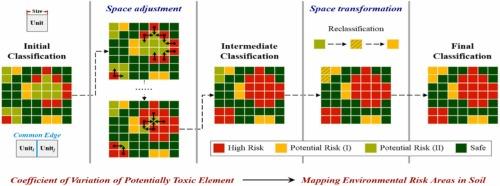土壤中潜在有毒元素的空间异质性分析及其在环境风险区制图中的应用
IF 11.3
1区 环境科学与生态学
Q1 ENGINEERING, ENVIRONMENTAL
引用次数: 0
摘要
潜在有毒元素(pte)是土壤环境管理的一个重要焦点。主动识别与pte相关的风险是一个关键的研究焦点。本研究利用土壤pte的空间变异系数,对比传统的污染评价方法。通过整合离群点检测和尺度变换,我们旨在创建一个自动化的风险区域识别和制图过程,分析离群点确定条件和空间分辨率如何影响风险区域制图。结果表明:(1)严格的判定条件(Z-scores>2)可以准确地识别高风险区域,但以牺牲潜在风险区域为代价(准确率仅为6%)。相比之下,宽松的确定条件(Z-scores>3)将识别误差分布在不同的风险水平上,这不利于识别和绘制高风险区域。(2)空间分辨率的提高提高了风险区识别的精度;然而,必须在映射精度和计算速度之间取得平衡。为此,本研究提出了一个衰减指数来量化分辨率与高风险区识别之间的关系。本文章由计算机程序翻译,如有差异,请以英文原文为准。

Spatial Heterogeneity Analysis of Potentially Toxic Elements for Mapping Environmental Risk Areas in Soil
Potentially Toxic Elements (PTEs) are a critical focus of soil environmental management. Proactively identifying risks associated with PTEs is a key research focus. This study utilized the spatial variation coefficient of soil PTEs, contrasting traditional pollution evaluation methods. By integrating outlier detection and scale transformation, we aimed to create an automated risk zone identification and mapping process, analyzing how outlier determination conditions and spatial resolution affect risk zone mapping. The results indicate: (1) Strict determination conditions (Z-scores>2) can accurately identify high-risk zones but at the expense of potential risk zones (accuracy rate of only 6%). In contrast, lenient determination conditions (Z-scores>3) distribute identification errors across different risk levels, which are detrimental to the identification and mapping of high-risk zones. (2) Higher spatial resolution improves the precision of the identified risk zones; however, a balance must be established between mapping accuracy and computational speed. To this end, this study proposes a decay index to quantify the relationship between the resolution and high-risk zone identification.
求助全文
通过发布文献求助,成功后即可免费获取论文全文。
去求助
来源期刊

Journal of Hazardous Materials
工程技术-工程:环境
CiteScore
25.40
自引率
5.90%
发文量
3059
审稿时长
58 days
期刊介绍:
The Journal of Hazardous Materials serves as a global platform for promoting cutting-edge research in the field of Environmental Science and Engineering. Our publication features a wide range of articles, including full-length research papers, review articles, and perspectives, with the aim of enhancing our understanding of the dangers and risks associated with various materials concerning public health and the environment. It is important to note that the term "environmental contaminants" refers specifically to substances that pose hazardous effects through contamination, while excluding those that do not have such impacts on the environment or human health. Moreover, we emphasize the distinction between wastes and hazardous materials in order to provide further clarity on the scope of the journal. We have a keen interest in exploring specific compounds and microbial agents that have adverse effects on the environment.
 求助内容:
求助内容: 应助结果提醒方式:
应助结果提醒方式:


